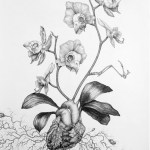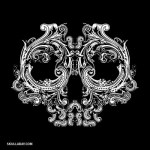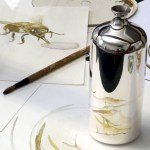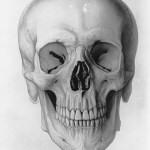skull
The skull of a juvenile white-tailed deer (Odocoileus virginianus), photographed in suburban Pennsylvania.
Orchis Nodulosa
Kate Street
The delicacy of Kate Street's pencil drawings belie their sinister undertones: a garden of chimeric orchids flowering with skulls, intricate skeletons of birds perching on leaves, tuberous roots that are half heart and half honeycomb. Her installations, on the other hand, pull no punches. In Bird in the Hand II, disembodied hands clinically display the fragments of a dissected bird.
Street told London's Timeout.com,
My interest in nature is how we like to classify it and manicure it and make it perfect. I like Dutch still lifes of flowers and animals because…
Ornament(al) Skull
Noah Scalin
Anatomophiles alert: tomorrow, Noah Scalin, proprietor of the Skull-A-Day blog and author of Skulls, opens a new show at the Quirk Gallery in Richmond, VA.
I just typed "Richmoaned". Does that qualify as a Freudian slip? Or something else?
For the longest time, people believed that the world's largest lizard, the Komodo dragon, killed its prey with a dirty mouth. Strands of rotting flesh trapped in its teeth harbour thriving colonies of bacteria and when the dragon bites an animal, these microbes flood into the wound and eventually cause blood poisoning.
But that theory was contested in 2005 when Bryan Fry from the University of Melbourne discovered that a close relative, the lace monitor, has venom glands in its mouth. The discovery made Fry suspect that Komodo dragons also poison their prey and he has just confirmed that in…
The Ambassadors, 1533
Hans Holbein the Younger
In the artistic technique called anamorphosis, an object is depicted in distorted perspective, so that the viewer has to take special action, like looking from a specific angle, to see the "correct" image.
The most famous example of anamorphic painting is Hans Holbein's The Ambassadors (1533), a double portrait in which the illusion of highly detailed reality is fractured by a blurred grey streak superimposed across the painting's bottom third. If one stands at an acute angle, close to the painting, the blurred streak resolves itself into a…
This detailed medical illustration by the late Duncan Winter shows the advantages of a good medical illustration over a typical photograph. There are no problems with over- or under-exposure, no depth-of-field issues, and the salient features are subtly emphasized. The underside in particular is very impressive work - there's a lot going on down there and it's really tough to draw clearly.
From the medical illustration flickrset by Bottled Monsters



